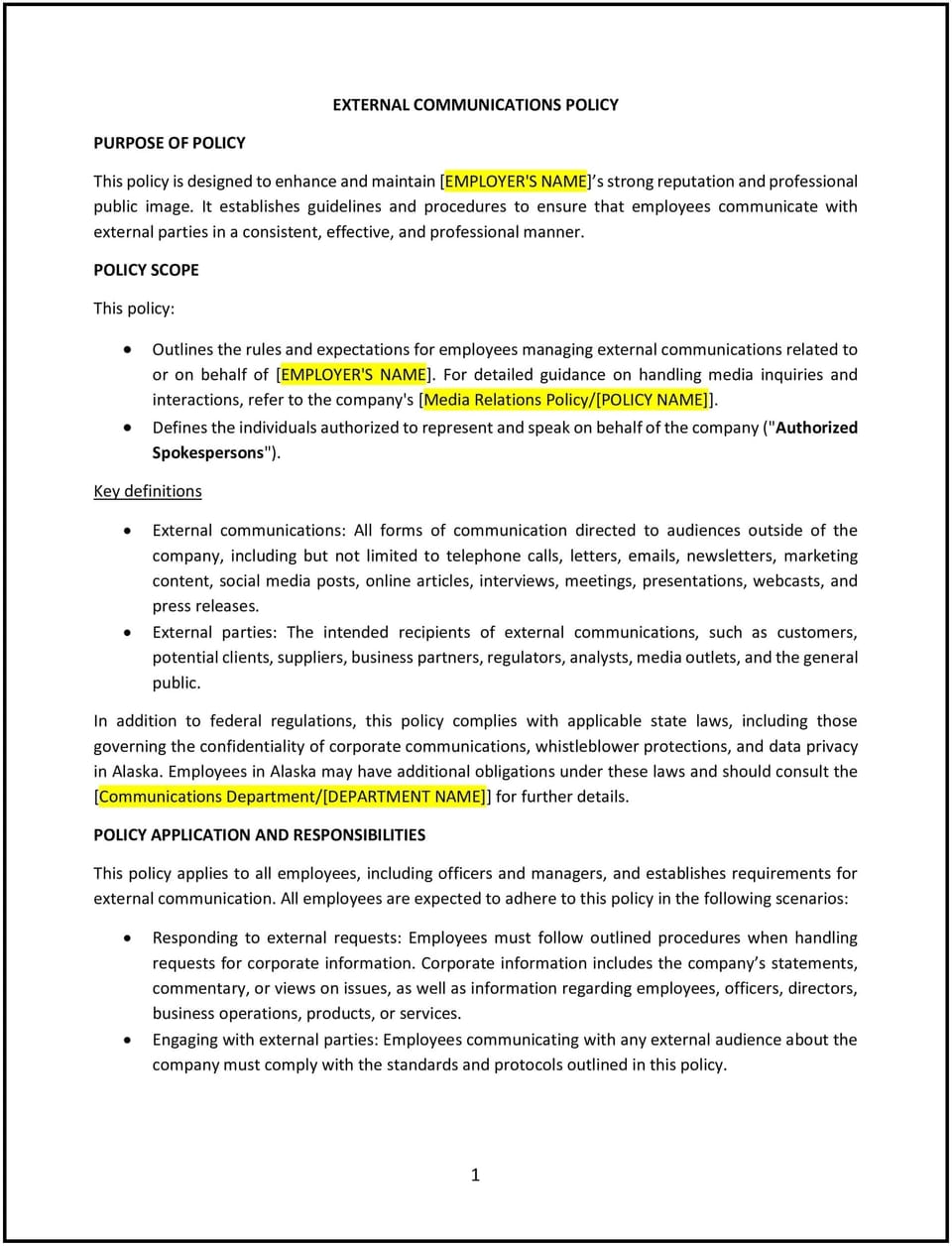External communications policy (Alaska): Free template

External communications policy (Alaska)
In Alaska, an external communications policy provides guidelines for how employees should represent the company when interacting with clients, partners, the media, or the public. This policy ensures that all external communication aligns with the company’s brand, values, and legal obligations while protecting sensitive information. By implementing this policy, businesses can maintain consistency, safeguard their reputation, and minimize risks of miscommunication.
Given Alaska’s unique industries and remote work dynamics, businesses may need to address challenges such as managing communications across time zones, ensuring internet reliability, or tailoring messages to specific audiences.
How to use this external communications policy (Alaska)
- Define communication channels: Specify approved channels for external communication, such as official email, company social media accounts, or press releases.
- Assign spokespersons: Identify individuals authorized to speak on behalf of the company, such as executives, PR representatives, or department heads.
- Address confidentiality: Emphasize the importance of protecting sensitive company information and outline procedures for handling media inquiries or public statements.
- Provide brand guidelines: Include key messaging points, tone of voice, and visual branding elements to ensure consistency in all external communications.
- Offer training: Educate employees on best practices for communicating with external parties, including email etiquette, social media usage, and crisis response protocols.
Benefits of using an external communications policy (Alaska)
An external communications policy provides significant advantages for businesses in Alaska. Here’s how it helps:
- Protects the company’s reputation: Ensures that all public-facing communication reflects the company’s values and professionalism.
- Reduces risks: Minimizes legal and operational risks by providing clear guidelines for handling sensitive information and public statements.
- Promotes consistency: Aligns external communication with the company’s brand, ensuring a cohesive message across all channels.
- Enhances efficiency: Streamlines communication processes by designating roles and responsibilities for interacting with external parties.
- Supports compliance: Helps businesses adhere to industry-specific regulations or standards regarding public disclosures and client communications.
Tips for using an external communications policy (Alaska)
- Tailor to local industries: Adapt messaging to reflect the unique characteristics of Alaska’s industries, such as tourism, resource management, or environmental initiatives.
- Address remote communication: Include guidelines for managing external communications in remote settings or during emergencies, such as using satellite phones or alternative internet solutions.
- Monitor digital channels: Implement processes for monitoring and managing company social media accounts to ensure timely responses and appropriate content.
- Establish escalation protocols: Create a process for escalating complex or sensitive communications to designated spokespersons or leadership.
- Review regularly: Update the policy to reflect changes in technology, industry standards, or company practices.
Q: How should I decide who is authorized to speak on behalf of the company?
A: Designate spokespersons based on their roles and expertise, such as executives, PR representatives, or department heads, to ensure accurate and professional communication.
Q: What guidelines should I provide for handling media inquiries?
A: Instruct employees to refer all media inquiries to designated spokespersons and avoid making unofficial statements. Provide clear procedures for escalating such inquiries.
Q: How can I ensure external communication aligns with the company’s brand?
A: Develop and share brand guidelines, including tone, key messaging, and visual elements, and ensure all employees are trained to use them consistently.
Q: What should I include in the policy to address social media usage?
A: Include rules for managing official accounts, monitoring activity, and responding to comments or messages professionally and promptly.
Q: How often should this policy be reviewed and updated?
A: Review the policy annually or whenever significant changes occur in technology, branding, or communication practices to ensure it remains relevant and effective.
This article contains general legal information and does not contain legal advice. Cobrief is not a law firm or a substitute for an attorney or law firm. The law is complex and changes often. For legal advice, please ask a lawyer.


